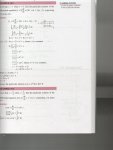You are using an out of date browser. It may not display this or other websites correctly.
You should upgrade or use an alternative browser.
You should upgrade or use an alternative browser.
Why modulus sign omitted?
- Thread starter yellup
- Start date
Actually I see it this way..
Hi stapel, (Dunno how to greet forgive me if i greet inappropriately),
Actually I see it this way (in the attachment), because at line 20, they got A=-1 as the answer (after the substitution), but at line 14, they take A=e^c which means that A will never smaller than zero.
Besides if the modulus is removed without any additional explanation, it is like saying there's no solution if (y-3)/(x+2) is smaller than zero while in reality there is. Correct me if im wrong.
Hi stapel, (Dunno how to greet forgive me if i greet inappropriately),
Actually I see it this way (in the attachment), because at line 20, they got A=-1 as the answer (after the substitution), but at line 14, they take A=e^c which means that A will never smaller than zero.
Besides if the modulus is removed without any additional explanation, it is like saying there's no solution if (y-3)/(x+2) is smaller than zero while in reality there is. Correct me if im wrong.
Attachments
- Joined
- Feb 4, 2004
- Messages
- 16,583
I hadn't read the first scan all the way to the end. I hadn't noticed that they'd arrived at a negative value for \(\displaystyle e^c\). As such, yeah, I think they erred in not either retaining the absolute-value bars or else using a "plus-minus" sign (as you did) to allow for the negative value of \(\displaystyle A\)....at line 20, they got A=-1 as the answer....
Sloppy and lazy work on their part. Sharp work on your part!


